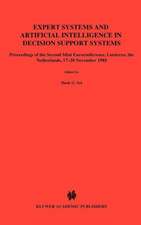The Knowledge Acquisition and Representation Language, KARL
Autor Dieter Fenselen Limba Engleză Paperback – 26 sep 2012
| Toate formatele și edițiile | Preț | Express |
|---|---|---|
| Paperback (1) | 985.35 lei 43-57 zile | |
| Springer Us – 26 sep 2012 | 985.35 lei 43-57 zile | |
| Hardback (1) | 991.60 lei 43-57 zile | |
| Springer Us – 30 aug 1995 | 991.60 lei 43-57 zile |
Preț: 985.35 lei
Preț vechi: 1231.69 lei
-20% Nou
Puncte Express: 1478
Preț estimativ în valută:
188.54€ • 197.39$ • 156.01£
188.54€ • 197.39$ • 156.01£
Carte tipărită la comandă
Livrare economică 07-21 aprilie
Preluare comenzi: 021 569.72.76
Specificații
ISBN-13: 9781461359593
ISBN-10: 1461359597
Pagini: 264
Ilustrații: XIX, 238 p.
Dimensiuni: 155 x 235 x 14 mm
Greutate: 0.37 kg
Ediția:Softcover reprint of the original 1st ed. 1995
Editura: Springer Us
Colecția Springer
Locul publicării:New York, NY, United States
ISBN-10: 1461359597
Pagini: 264
Ilustrații: XIX, 238 p.
Dimensiuni: 155 x 235 x 14 mm
Greutate: 0.37 kg
Ediția:Softcover reprint of the original 1st ed. 1995
Editura: Springer Us
Colecția Springer
Locul publicării:New York, NY, United States
Public țintă
ResearchDescriere
Within the framework of so-called second generation expert systems [62] knowledge modeling is one of the most important aspects. On the one hand, knowledge acquisition is no longer seen as a knowledge transfer process, rather it is now considered as model construction process which is typically a cyclic and error prone process. On the other hand, the distinction between knowledge and symbol level descriptions [166] resulted in various proposals for conceptual knowledge models describing knowledge in an implementation independent way. One of the most prominent examples of such a conceptual model is the KADS model of expertise which is characterized by its clear distinction of different know ledge types and by the usage of specific modeling primitives to describe these different knowledge types [185]. The semi formal KADS expertise model entails all the advantages and disadvantages which have been identified for semi-formal system models e.g. in the software engineering community.
Cuprins
1 Introduction.- 1.1 Model-based and Incremental Knowledge Engineering.- 1.1.1 Model-based Knowledge Engineering.- 1.1.2 Incremental Knowledge Engineering.- 1.1.3 MIKE.- 1.2 The Knowledge Acquisition and Representation Language KARL.- 1.2.1 A Model of Expertise in KARL.- 1.2.2 Why not using VDM or Z.- 1.2.3 The Formal Semantics.- 1.2.4 The Implementation.- 1.2.5 Case Studies.- 1.3 Some Arguments about Formal and Operational Specification Languages.- 1.3.1 The Knowledge of Experts Cannot or not Adequately be Described Formally.- 1.3.2 Formal Languages are Difficult to Learn.- 1.3.3 Formal Specifications are too Complex and too Difficult to Understand.- 1.3.4 Formal Specifications are too Expensive.- 1.3.5 Should a Specification Language be Executable or Not.- 2 Logical-Karl.- 2.1 Significant Ideas of Other Approaches Used for L-KARL.- 2.1.1 Object-orientation and Equality.- 2.1.2 Reasoning About Classes.- 2.1.3 Integration of Well-typing Into a Model-theoretical Semantics.- 2.1.4 Set-valued Attributes.- 2.1.5 Minimal and Perfect Models as Semantics.- 2.2 Syntax of L-KARL.- 2.3 Informal Semantics of L-KARL.- 2.3.1 ID Terms.- 2.3.2 Class and Predicate Definitions.- 2.3.3 Literals.- 2.3.4 The Difference Between Objects and Values.- 2.3.5 The Well-typing Conditions.- 2.3.6 Formulae.- 2.3.7 Constraints.- 2.4 A Comparison with F-logic and O-logic.- 3 Procedural-Karl.- 3.1 Significant Ideas of Other Approaches Used for P-KARL.- 3.2 Syntax of P-KARL.- 3.3 Informal Semantics of P-KARL.- 4 The Karl Model of Expertise.- 4.1 The Sisyphus Example.- 4.2 The Domain Layer.- 4.2.1 Terminological Knowledge: The Domain Schema.- 4.2.2 Intensional Descriptions.- 4.2.3 Factual Knowledge.- 4.2.4 Necessary Descriptions.- 4.2.5 Data.- 4.2.6 Graphical Representation.- 4.2.7 The Domain Layer of the Sisyphus Example.- 4.3 The Inference Layer.- 4.3.1 An Alphabet of an Inference Layer.- 4.3.2 Roles.- 4.3.3 Elementary Inference Actions.- 4.3.4 Inference Structure.- 4.3.5 Graphical Representation.- 4.3.6 Inference Structures versus Dataflow Diagrams.- 4.3.7 The Inference Layer of the Sisyphus Example.- 4.4 The Task Layer.- 4.4.1 Language Primitives at the Task Layer.- 4.4.2 Graphical Representation.- 4.4.3 The Task Layer of the Sisyphus Example.- 4.5 The Model of Cooperation.- 4.5.1 Data.- 4.5.2 Control Information.- 5 The Formal Semantics of Karl.- 5.1 The Formal Semantics of L-KARL.- 5.1.1 Model Theory of L-KARL.- 5.1.2 Herbrand Models.- 5.1.3 Minimal Model Semantics.- 5.1.4 Perfect Model Semantics.- 5.1.5 Constraints.- 5.1.6 Built-in Predicates.- 5.2 The Formal Semantics of P-KARL.- 5.3 The Formal Semantics of a Domain Layer.- 5.4 The Formal Semantics of an Inference Layer.- 5.5 The Formal Semantics of a Task Layer.- 6 Conclusion.- 6.1 Highlights of KARL.- 6.2 Related Work.- 6.2.1 A Comparison with (ML)2.- 6.2.2 KARL and Structured Analysis.- 6.3 Shortcomings of KARL.- 6.3.1 Current Limitations of KARL.- 6.3.2 Actual Limitations of KARL.- 6.4 Future Work.- 6.4.1 Validation of Conceptual Models.- 6.4.2 Formal Specifications of Reusable Problem-Solving Methods.- References.























